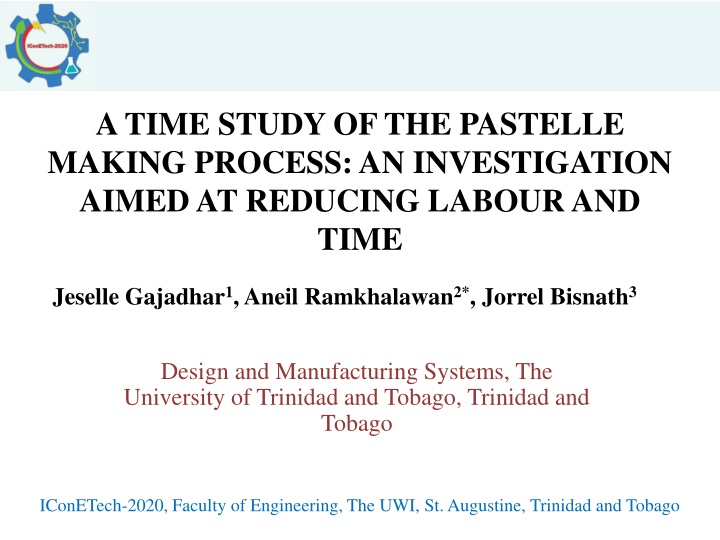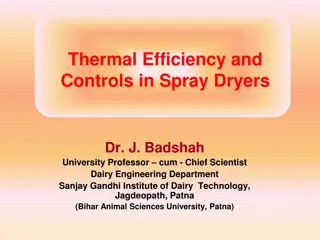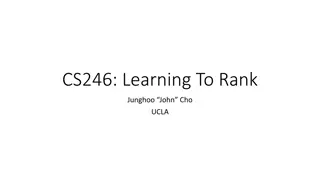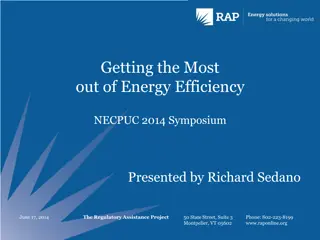A Study on Optimizing Pastelle Making Process for Efficiency
This study focuses on analyzing the pastelle making process to reduce labor and time involved, aiming to enhance productivity for both home cooks and catering businesses. The research involves conducting time studies, literature surveys, and developing a device to streamline the production process. By investigating existing technology and user preferences, the goal is to design a user-friendly device that can expedite pastelle preparation while maintaining quality standards.
Download Presentation

Please find below an Image/Link to download the presentation.
The content on the website is provided AS IS for your information and personal use only. It may not be sold, licensed, or shared on other websites without obtaining consent from the author.If you encounter any issues during the download, it is possible that the publisher has removed the file from their server.
You are allowed to download the files provided on this website for personal or commercial use, subject to the condition that they are used lawfully. All files are the property of their respective owners.
The content on the website is provided AS IS for your information and personal use only. It may not be sold, licensed, or shared on other websites without obtaining consent from the author.
E N D
Presentation Transcript
A TIME STUDY OF THE PASTELLE MAKING PROCESS: AN INVESTIGATION AIMED AT REDUCING LABOUR AND TIME Jeselle Gajadhar1, Aneil Ramkhalawan2*, Jorrel Bisnath3 Design and Manufacturing Systems, The University of Trinidad and Tobago, Trinidad and Tobago IConETech-2020, Faculty of Engineering, The UWI, St. Augustine, Trinidad and Tobago
INTRODUCTION Pastelles are a seasonal staple enjoyed primarily at Christmas time by Trinidadians Pastelle production is limited to home cooks for personal consumption and/or low volume sales (output of 6 to 20 dozens based on demand) as well as established catering companies whose output goes up to the hundreds of dozens. In the catering business, chefs are always open to cutting down their preparation time for any item, to potentially expand their business via the ability to increase their supply to customers without sacrificing quality IConETech-2020, Faculty of Engineering, The UWI, St. Augustine, Trinidad and Tobago
OBJECTIVES To conduct a time study of the pastelle making process To determine if the processes can be done in a quicker and easy manner, with minimal effort needed from the user by design of a device IConETech-2020, Faculty of Engineering, The UWI, St. Augustine, Trinidad and Tobago
METHODOLOGY Conduct a literature survey on existing technology for the pastelle making process and include devices created to make similar types of food Conduct surveys with producers and consumers to determine buying habits and production rates Conduct time studies with various pastelle producers using the current production methods to determine which processes are time and effort consuming Use the design process to develop a device to reduce the time and effort Conduct interviews with users of the prototype to determine viability IConETech-2020, Faculty of Engineering, The UWI, St. Augustine, Trinidad and Tobago
LITERATURE SURVEY An assessment was conducted on existing technology for the pastelle making process including devices created to make similar types of food. Advantages and disadvantages of existing products Product Manual Pastelle Press Advantages Disadvantages Labour intensive Time consuming Ergonomically unfriendly design Useful only for pressing dough Only process one item at a time Does not require power supply Compact Portable Fairly light weight Allows for individual wrapping of pastelles Cheap ($22.00 - $45.00USD) IConETech-2020, Faculty of Engineering, The UWI, St. Augustine, Trinidad and Tobago
LITERATURE SURVEY X-press Pastelle Maker Does not require power supply Compact Does not allow for the use of fig leaves for wrapping the pastelle Does not allow for individual wrapping of pastelles; based on the product's design, pastelles are wrapped in groups of three Labour intensive Portable Fairly light weight Produces multiple pastelles simultaneously Cheap ($45.00USD) IConETech-2020, Faculty of Engineering, The UWI, St. Augustine, Trinidad and Tobago
LITERATURE SURVEY This included devices created to make similar types of food. IConETech-2020, Faculty of Engineering, The UWI, St. Augustine, Trinidad and Tobago
DATA GATHERING Time studies were conducted with various pastelle producers using the current production methods Time taken (s) Data collected Candidates 1 51.48 100.21 31.23 15.94 20.11 8.81 25.94 50.07 1.34 516.2 Average between candidates 2 Average Maximum Minimum Average Maximum Minimum Average Maximum Minimum 19.92 21.03 19.38 15.63 21.82 10.14 74.97 205.41 20.33 599.6 35.7 60.6 25.3 15.8 21.0 9.5 50.5 127.7 10.8 557.9 Set-up time Press time Fold time Total Time for 6 Pastelles IConETech-2020, Faculty of Engineering, The UWI, St. Augustine, Trinidad and Tobago
DATA GATHERING Data for Pressing the dough was recorded with various pastelle producers using the current production methods Force Data collected kg 14.4 N Average 141.6 Pressing Force Maximum 20.4 200.2 Minimum 11.3 111.2 IConETech-2020, Faculty of Engineering, The UWI, St. Augustine, Trinidad and Tobago
DATA GATHERING Surveys with producers and consumers to determine user requirements Requirements D/W Options Material D Stainless Steel Not to exceed 1m long, 0.5m wide and 0.5m high D No loose parts once fully assembled Shield to be used at the pressing stage to ensure user does not damage their hand W Easy to operate by one person Source Standard Geometry W Market Survey Standard Safety D Standard Standard Ergonomics W Pleasant appearance Market Survey Operation D Powered by 115VAC Supply Standard Cost W Must cost no more than $6000TTD Market Survey W Should require little to no maintenance Standard Maintenance Must be modular to allow for easy disassembly and cleaning W Standard IConETech-2020, Faculty of Engineering, The UWI, St. Augustine, Trinidad and Tobago
FINDINGS OF THE TIME STUDY It was determined that the time and actions of pressing the corn meal dough and folding the pastelles can be reduced by design of a device The number of pastelles can be increased in a specified time and/or by decreasing the effort needed, on the part of the maker to produce the pastelles (user got weary and if this effort is removed then more pastelles can be made) IConETech-2020, Faculty of Engineering, The UWI, St. Augustine, Trinidad and Tobago
RESULTS Constructed Alpha Prototype IConETech-2020, Faculty of Engineering, The UWI, St. Augustine, Trinidad and Tobago
RESULTS A time study was conducted using the Prototype and compared to data collected before the prototype Comparison of data before and after using Prototype Process stage Data collected before prototype 15.8 9.5 21.0 50.5 10.8 127.7 Data collected using prototype 30.6 28.0 43.1 8.9 3.1 37.7 Criteria average fastest slowest average fastest slowest Press time Fold Time IConETech-2020, Faculty of Engineering, The UWI, St. Augustine, Trinidad and Tobago
RESULTS Comparison of data before and after using Prototype Time (s) to make 6 Pastelles Before Prototype 516.2 599.6 557.9 Criteria After Prototype 481.5 1174.8 688.64 Fastest Slowest Average IConETech-2020, Faculty of Engineering, The UWI, St. Augustine, Trinidad and Tobago
RESULTS User Feedback Pros Cons Relatively lightweight Placement of the fig leaf over the folding plate Folding plate Positioning of the upper press plate Small footprint The base of the device too small Speed of pressing arm IConETech-2020, Faculty of Engineering, The UWI, St. Augustine, Trinidad and Tobago
CONCLUSIONS The device was able to reduce the time taken by users in folding pastelles Average pressing time increased, but the consistency of the pressed dough was increased The results also indicated that as the user gained more familiarity with the machine, their production time reduced. Therefore, with more testing by the same users, this pressing time and hence production time can be reduced further Production can also be improved by changing the actuator to increase the time and also automating this part of the process The device was however able to assist users by removing the physical output usually required for the pressing of the pastelles IConETech-2020, Faculty of Engineering, The UWI, St. Augustine, Trinidad and Tobago
REFERENCES M. G. Martinez, Tortilla Maker . United States of America Patent 4664025, 29 July 1987. A. d. l. V. E. M. L. Manuel J. Rubio, Tortilla Press Apparatus . United Stated of America Patent US4938126A, 9 May 1988 Trinidad & Tobago Bureau of Standards, TTS 76: Part 13:2016- Requirements for labelling- Part 13: Labelling for Electrical Appliances, Trincity: Trinidad & Tobago Bureau of Standards, 2016 IConETech-2020, Faculty of Engineering, The UWI, St. Augustine, Trinidad and Tobago
THANK YOU! IConETech-2020, Faculty of Engineering, The UWI, St. Augustine, Trinidad and Tobago























